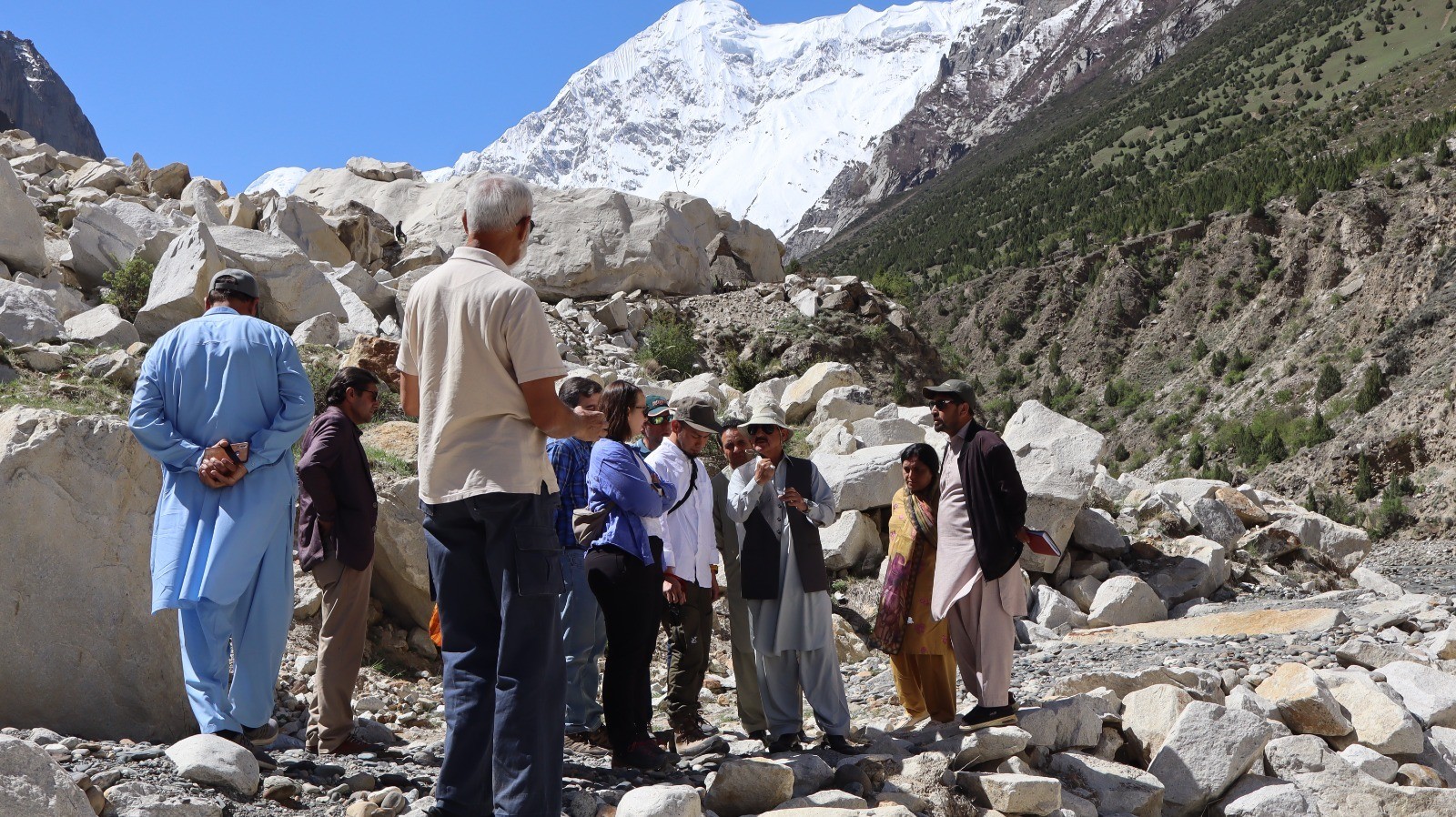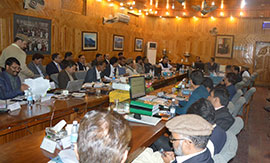
Enhancing Employability & Leadership for Youth
Description: (Same content as on the Website No need to Change any of it)
The Enhancing Employability and Leadership for Youth (EELY) Program is a six-year initiative of the Aga Khan Rural Support Program (AKRSP) and the Aga Khan Foundation funded by the Government of Canada, Global Affairs Canada (Formerly DFATD) and the Aga Khan Foundation (AKF) Canada. It recognizes that youth have a critical role to play in determining the future of Gilgit‐Baltistan and Chitral (GBC). The programme aims to increase engagement of youth as productive and full members of federally administered Gilgit-Baltistan region and district Chitral in Kyber Pukhtukhwa. EELY contributes to this ultimate outcome through two complementary components: youth employability and youth engagement and leadership. The youth employability component seeks to enhance professional skills development and enterprise support services. The expected intermediate outcome result or slogan of employability component is Increased and more equitable employability of young men and women in Gilgit-Baltistan and Chitral.
The expected immediate outcome results of this component are as follows:
- Sustainable improvement in quality, outreach and relevance of skill development services (technical, vocational and entrepreneurial) for young men and women
- Sustainable and more equitable integration of economic actors into effective market systems to improve youth livelihoods
EELY targeted Beneficiaries: 189,000 beneficiaries over the life of the project, almost half of whom were young women.
EELY Goal and Objectives:
The basic premise of the project was that young women and men of the area will play a major role in determining the future direction of GBC and therefore, should be considered central players in the development process through their inclusion in decision-making bodies.
The project’s ultimate outcome:
It was to increase engagement of youth as productive and full members in Gilgit-Baltistan and Chitral. And was expected to be achieved through two intermediate outcomes:
- Increased and more equitable employability of young women and men in Gilgit-Baltistan and Chitral.
- Increased and more equitable engagement between and among male and female youth leaders, community institutions and local government to address the needs of youth in Gilgit-Baltistan and Chitral.
The project’s expected immediate outcome results:
1.1 Sustainable improvement in quality, outreach and relevance of skill development services (technical, vocational and entrepreneurial) for young women and men.
1.2 Sustainable and more equitable integration of economic actors into effective market systems to improve youth livelihoods.
2.1 Improved and more equitable participation of young women and men in community and civic institutions.
2.2 Enhanced capacity of relevant community and state institutions to develop and extend enabling programs for the equal development of young women and men
Overall Results in Figures:
- Against a target of benefitting 63,000 youth, the project has directly benefitted 77,680 youth; including 42,253 young men (54%) and 35,427 young women (46%). In addition to directly benefitting 77,680 youth in GBC, EELY has indirectly reached approximately 174,355 youth (81,501 young women, or 47%) in GBC against a target of 126,000.
Key results of the project:
- Over the project period, a cumulative number of 2,249 youth including 1,167 young men and 1,082 young women have been provided with professional internships. Data from tracer studies conducted on EELY internship graduates have shown that 48% of young men and 41% of young women became fully employed in public and private sector organizations within six months of completion.
- Under the marketable skills development program, a total of 3,361 youth, including 2,184 young men and 1,177 young women, have been trained in a wide range of technical skills such as: plumbing, carpentry, auto mechanics, electric, beauty, construction machinery operator, porters, cooking, tailoring, embroidery, handicrafts, and fruit and vegetable processing.
- Since baseline the average monthly income of EELY beneficiaries has risen from PKR 8,603 to 21,253 (almost PKR 4,000 higher than non-participants). Results are particularly impressive in Chitral where young men from the EELY project make an average of PKR 34,698 (compared to PKR 14,333 of non-participating men) and young women make PKR 19,388 (compared to PKR 6,375 of non-participating women).
- A key indicator of economic empowerment is the ability to make decisions over financial assets; since the baseline the proportion of young women who make joint or sole decisions on how to use their money has increased from 58.4% to 95.8% among EELY beneficiaries.
- Combined with increased regional stability, the availability of improved tourism services, wide scale destination promotion, and publicity interventions led by youth under EELY, the number of tourists to GBC has increased from 30,000 in 2012 to 250,000 in 2015. The government of Gilgit-Baltistan has acknowledged the role that EELY has played in this sharp increase during the 2016 project steering committee.
- The Young Community Leadership Development Program (YCLDP) and the local support organization (LSO) capacity building programs have resulted in increased participation of youth in community organizations. An YCLDP study and labour market assessment (LMA) midline survey have confirmed that 40% of young men and 31% of young women are serving community organisations in management/leadership roles.
- As a result of EELY’s youth focus, there is increased GB government and private sector support for youth development, specifically skills delivery, internships and gender equality (i.e. the GB government contributed PKR 4.4m towards internships over the last three years and have agreed to extend for two years beyond EELY).
Key Highlights of the accomplishments during the life of the project:
- Completed a comprehensive Labour Market Assessment for the Gilgit-Baltistan and Chitral regions in collaboration with government, the first of its kind in the region;
- Over 1500 Youth provided TVET skills and placement opportunities
- Over 900 young men and women received internship in collaboration with government and private sector institutions
- 2,000 Youth trained in entrepreneurship
- 300 Youth received start up Micro-Challenge Award to implement social and business ideas
- Created the electronic youth portal for the Gligit-Baltistan and Chitral region (www.gbcyouth.org.pk), which provides youth with access to information on employment, skills development and leadership opportunities;
- 5,100 Youth received Life Skill Training and another 2,500 Youth received training on Young Community Leadership (YCLDP)
- 5,600 Youth received services from supported Youth Organizations (YOs)
- 5,000 youth (over 70% women) mobilized to take membership of 320 Community Based Saving Groups (CBSGs)
- Ongoing support to over 50 Local Support Organizations (LSOs) for sustainability and implementing youth specific programs at union council level
- Provided need based support to GB and district Government in Chitral to development and implement youth programs and policies
- Support provided to GB Government to implement Diamer Youth Development Program through Diamer Poverty Alleviation Programme (DPAP)
Ultimate Outcome against the above-mentioned indicators:
Increased engagement of youth as productive and full members in GilgitBaltistan and Chitral
The government cabinet division data shows that 18% of the GBLA members are young women (9%) and men (9%).
At baseline, 11% of GBLA members were young men (three out of 27 members) and 7.4% were young women (two out of 27 members). The comparison shows that although the youth membership in GBLA has slightly increased (from a baseline of six members at endline) the effect is neutralized due to the fact that size of GBLA was also increased from 27 total members to 33 during the 2015 elections. However the proportion of young women members amongst the youth members showed an increase and equal number of young female and male members (three each) elected to the GBLA.
District Councils and Union Councils did not exist prior to 2008 in Gilgit-Baltistan. However, the youth representation in the District Councils of Chitral district of Khyber-Pakhtunkhwa province are provided below. Thirty-seven percent of the total seats were youth. The only young women were the women in the women’s members reserved seats.
The participation of the total population of youth in community organizations has also increased by seven percent during the EELY project period from 23% at baseline to 30%. This included a four percent increase for young men and three percent increase for young women.
Monthly earnings of the target group:
According to the external end line evaluation, the average monthly gross income of youth with an income source was PKR 21,253. This is two and a half times the average monthly income of PKR 8,317 reported in the baseline survey. There was a significant difference in the mean income of youth participating in EELY projects (PKR 21,911) compared to non-participants (PKR 17,173). However, gross incomes of salaried persons (PKR 22,144) were higher than those of self-employed youth (PKR 20,865). This is possibly due to the fact that businesses normally take two to three years before generating significant profits.
The data suggests that the project has had an impact in improving employability, particularly self-employment, among youth, and contributed to a significant improvement in their incomes.
What is most interesting about the results is the differences for young women and men. While the difference between EELY and non-EELY young men is quite small in Gilgit and Baltistan, partially attributed to a general economic boost in the region, the increase in female income is 22% to 204% depending on the region. As the EELY project evolved, it increasingly tightened its focus on WEE and this demonstrates that EELY’s young women were able to enter the economy and earn an income. It is noted however, that even while women are earning more, the inequality in income between women and men has also increased, especially in Baltistan and Chitral.
Young women and men employed, unemployed and underemployed:
The endline survey demonstrated that, among EELY beneficiaries, 77.7% of young men are employed, and 76.4% of young women are employed. The endline report classified employment as working for a wage or self-employment. This represents a 6.4% increase for young men from the baseline and a 28.2% increase for young women.
The most common sources of income were professional, technical and related work, business, sales, or trading, while home based work, service, administrative and managerial jobs, and agriculture also provided income to a substantial number of youth. A significant proportion of youth (44%) started their own business or income generating activity during the last two years
A far greater proportion of beneficiary (40%) compared to non-beneficiary (18%) youth were working as self-employed workers, indicating a substantial impact of the project in creating self-employment in youth. A greater proportion of youth of Baltistan (44%), compared to Gilgit (33%) and Chitral (30%) regions, was self-employed.
In fact 62% of women compared to 32% of men said that they had started their own business or other income generating activity during the last two years, indicating that the project had a large impact in supporting young women to start businesses. Most of the women were involved in tailoring, carpet-weaving and handicrafts (33%) and in running ECD centres (30%). In turn, some professions only had men working in them (e.g. construction, transport and storage, air conditioning repair, and plumbing).
Perhaps related to the high percentage of EELY beneficiaries in self-employment (versus the rest of the population) is that, with the exception of young women in Chitral, EELY beneficiaries are behind their non-EELY counterparts in every region for waged employment. This can be explained partially by the EELY demographics (education, skill level, location), but also by the temptation of starting an enterprise
There were clear gender differences in wage-earning status. One-third of men (31%) worked for a salary/wage, compared to only 18% women. Again, this is likely due to the fact that 70% of surveyed employers responded that they do not hire women at their workplace.






